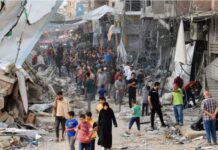Last Sunday, the Egyptians woke up to the tragedy of the death of 41 people, including 18 children, and the injury of 14 others, after a fire broke out in the Church of Martyr Mercurius Abu Sefein in the Imbaba district of Giza governorate during Sunday mass. The small church, whose area does not exceed 120 meters, is in a popular area known for its dense population. According to officials, about 5,000 people attended Sunday masses, which did not meet the most specific safety and civil protection standards. This exacerbated the tragedy and increased the number of victims.
This raises many questions about the conditions of churches in Egypt, and the requirements for their construction, amid accusations that the government is obstructing the construction of appropriate places of worship for Christians, which forces them to take homes that do not meet any standards of safety and security as churches. The Orthodox Church is also accused of colluding with the government, not taking a solid position, and being serious about obtaining the rights of the Copts in safe places of worship.
Egyptian Christians have faced a crisis for decades, and perhaps centuries, in building new churches. This is due to the discriminatory sectarian laws, which complicate the issuance of decisions to build new churches and assign the task of organising the construction of places of worship almost exclusively to the security services that use them as a bargaining chip for the church and blackmail it.
The legal difficulties encountered in the process of building churches, in addition to the rejection of a section of Muslim citizens and the surrender of state agencies to these local objections, led to the emergence of what can be called house-shaped churches. The need created a kind of circumvention of the construction difficulties. In many cases, Coptic citizens resort to buying a house, demolishing its interior walls, and emptying it to make it suitable for practising religious rites or building a building in the form of a small factory, then practising religious rituals regularly and appointing a cleric to perform religious traditions. Law No. 80 of 2016 regulating the construction and restoration of churches partially resolved some of the problems of building churches. Still, it codified the conditions of dozens of churches without meeting the approved building requirements. The most prominent example is the Church of Martyr Mercurio’s Abu Seifin in the Imbaba neighbourhood, where the disaster occurred. The church was initially built as a 4-storey house inside a narrow street in a densely populated area due to the difficulty of obtaining a permit. Not officially legalising its status did not officially legalise its position until 2019. However, this did not lead to its entry into safety and protection conditions.
According to the Egyptian Firefighting Code, any property where a large number of people (hospital, school, factory, etc.) flock to it must contain early warning devices for fires, an automatic system to eliminate the fire, in addition, to escape ports in the event of a fire. But all these conditions were not met in Abu Sefein Church, which increased the number of victims. This catastrophe is likely to be repeated again and again in hundreds of churches, whether licensed or not, which were built decades ago with the knowledge of state agencies and where prayers are prayed. Their condition is worn and does not meet the needs and codes of construction and security and safety standards. The only solution now to end this crisis is for the state to activate its role and assume its responsibility to review all the small churches scattered in villages, hamlets, and popular slum areas and re-evaluate them so that the neglected ones are demolished and rebuilt, or safety requirements and fire codes are met in those that are not dilapidated.









